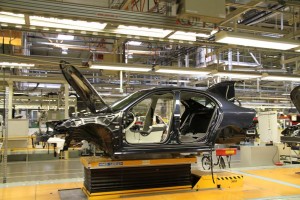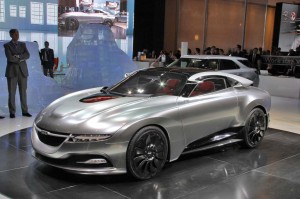Shortly before its seemingly final collapse, struggling Swedish automaker Saab rolled out a striking concept vehicle it dubbed the Phoenix. Despite generally positive reviews, the prototype wasn’t enough to save Saab from collapse, but now under new ownership, Saab is once again trying to rise from the ashes – and the Phoenix could be the long-term key.
For now, though, the new parent, National Electric Vehicle Vehicle Sweden, or NEVS, is focusing on building the old Saab 9-3 as it fires up the maker’s flagship Trollhattan assembly plant for the first time since April of 2011.
Just two cars rolled down the line this week, and “We need to finalize a few remaining dialogues to build partnerships with suppliers (before a formal decision is made) to start production of Saab cars,” cautioned a statement from Mattias Bergman, the acting president of NEVS. But the goal is to have a turbocharged version of the 9-3 back in production before year end.
That could come as a shock to those who felt the Saab story ended for good when the company filed for bankruptcy in late 2011 and was formally declared insolvent by the Swedish courts shortly afterwards.
(Volvo Concept Coupe captures “essence” of Swedish maker’s past, says designer. Click Hereto see how.)
Founded in 1947, Saab struggled for most of its corporate life even after General Motors first acquired a major stake in the Scandinavian maker in 1989. Things appeared to take a turn for the better when GM took complete control in 2000 but sales never came close to the U.S. maker’s goal and Saab became one of four brands GM announced it would either sell or close when it plunged into bankruptcy in 2009.
In a surprise move, the company was purchased by little Spyker, a Dutch company known for its low-volume, high-priced sports cars. Spyker, it turned out, had big ambitions but little cash to back that up. In April 2011, unpaid suppliers boycotted the Swedish maker, bringing production to a halt. And despite repeated efforts to find new investors – or buyers – Saab quickly collapsed.
Key assets were sold, after the bankruptcy, to NEVS, a Japanese-Chinese consortium, for a reported $250 million. The firm’s stated goal is to use Saab platforms as a base for a new electric drivetrain though, at least initially, it will go with a turbocharged gasoline driveline. European reports suggest the electric powertrain will be introduced when an updated Saab 9-3 body is put into production next year.
Meanwhile, NEVS continues to focus on putting the Phoenix concept into production, or more precisely, to come up with a new model based on the underlying architecture of the Phoenix prototype which was inked by automotive stylist Jason Castriota.
(Former Saab parent Spyker set for comeback with launch of B6 Venator supercar. Click Here to check it out.)
As the statement from NEVS suggests, the new management team will have to overcome the concerns of suppliers burned by Spyker’s failed attempt to revive Saab – which left parts manufacturers holding millions of dollars in unpaid bills.
Another challenge will be to remove any components that would have to be sourced from General Motors which did not back the sale of Saab’s post-bankruptcy assets.
In fact, GM blocked efforts by former owner Spyker to bring in Chinese investors or to see the company outright to potential Chinese buyers as its collapse grew imminent. That last year prompted Spyker founder Victor Muller to file a $3 billion lawsuit against the U.S. automaker. A Detroit court tossed the suit out earlier this year but Muller last month told TheDetroitBureau.com he plans to proceed with an appeal of that decision.
(Court tosses Saab lawsuit. Click Here for the full story.)
The new Japanese-Chinese consortium has aggressive plans for the revived Saab, reportedly targeting sales of 120,000 9-3 models alone by 2016, which would come close to the brand’s previous peak of 133,000 sold in 2006. The goal is to restart distribution in Europe, open a dealer network in China and possibly re-enter the U.S. market – once Saab’s largest – later on.


